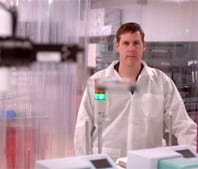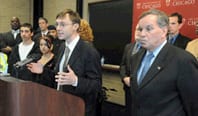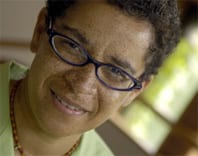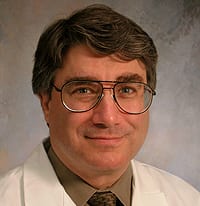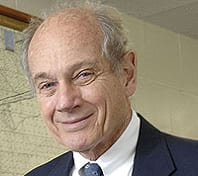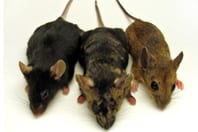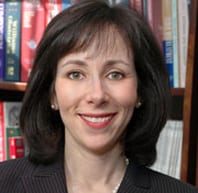Research and Discovery
Genetic Marker Revealed for High-Risk Breast Cancer Patients
A novel systems-based approach has led researchers to an important genetic marker that can help physicians know which breast cancer patients are at highest risk and will require more aggressive treatment. The researchers, led by Kevin White, the James and Karen Frank Family Professor in Human Genetics and Director of the Institute for Genomics & Systems Biology, found that high expression of the protein H2A.Z can help predict which patients are most at risk for disease spread and death, as well as serve as a new target for therapy. Perhaps most important, the scientists believe they have developed an integrated approach to genomic analysis that can be applied to a wide range of cancers.
Crime Lab Seeks Solutions to Violence
A team of University and national scholars is collaborating with the City of Chicago and local philanthropists to help reduce gun violence among youths as part of the larger University of Chicago Crime Lab initiative. Led by Jens Ludwig, the McCormick Tribune Professor in the School of Social Service Administration, Law School, and Irving B. Harris Graduate School of Public Policy Studies and a leading authority on crime and social policy, and Harold Pollack, Associate Professor in the School of Social Service Administration, the group is working with the city to develop interventions to reduce youth crime within a research framework that will provide the most scientifically rigorous evidence on effective solutions. “If this collaborative project is successful, the result would be fewer shootings of Chicago youth as a direct result of our pilot interventions,” Ludwig said.
Goldsby Throws Spotlight on America’s History of Lynching
Jacqueline Goldsby, Associate Professor in English Language & Literature, received the Modern Language Association’s William Sanders Scarborough Prize and was a finalist for the American Studies Association’s Lora Romero First Book Prize in recognition of A Spectacular Secret: Lynching in American Life and Literature, a narrative work that charts the history of lynching from the 1880s to the case of Emmett Till in 1955. While researching a bachelor’s honors thesis on the effects of racial violence in the early 1980s, Goldsby encountered the “missing history” of lynching in the United States. With little previous scholarship on the subject, she began to methodically examine the representation of lynching in American literature. “Instead of reading history into literary texts,” she said, “I read history out of them.”
Sloan Digital Sky Survey Changes Face of Astronomy
The Sloan Digital Sky Survey was ranked the world’s top high-impact astronomical observatory. Among the survey’s biggest surprises has been the discovery of remnant dwarf galaxies that have been pulled apart by the gravitational tides of Earth’s own Milky Way galaxy. Until SDSS came along, the discovery of a satellite galaxy near the Milky Way was comparable to the discovery of a new planet in the earlier days of astronomy. SDSS owes much of its success to the huge volume of data it has amassed. “The more data you have, the more likely it is you can find an extremely rare object,” said Richard Kron, Professor in Astronomy & Astrophysics and Director of SDSS. To date, the survey has collected data on nearly 200 million celestial objects, including galaxies, quasars, stars, and asteroids.
Medical Center Awarded $23 Million for Translational Research
The National Institutes of Health awarded one of twelve Clinical and Translational Science Awards for 2007 to a team at the University of Chicago Medical Center. The award, which provides close to $23 million over five years, will put scientists in contact with residents of the South Side of Chicago as part of an ongoing initiative to improve health care to underserved populations. Julian Solway, the Walter L. Palmer Distinguished Service Professor in Medicine and Pediatrics, will bring together a team that includes basic scientists from the biological, physical, behavioral, and social sciences; physician-scientists from the Pritzker School of Medicine; and faculty from the University of Chicago Booth School of Business, Irving B. Harris Graduate School of Public Policy Studies, and School of Social Service Administration.
Institute to Provide Robust Economics Forum
The Milton Friedman Institute for Research in Economics, launched in July 2008, will build on the University’s outstanding history of economics scholarship and become a destination for top scholars in years to come. The institute will encourage more of the leading-edge collaborative work already going on in the Department of Economics, Law School, and Chicago Booth, as well as attract visiting scholars from a wide variety of perspectives and postdoctoral students. “The goal of the institute is to build on the University’s existing leadership position and make the institute a primary intellectual destination for economics by creating a robust forum for engagement of our faculty and students with scholars and policy-makers from around the world,” said President Zimmer. The institute will occupy the current home of the Chicago Theological Seminary at 58th Street and Woodlawn Avenue by 2012.
Auger Collaboration Finds Source of High-Energy Cosmic Rays
The sprawling Auger Cosmic Ray Observatory in South America produced its first major discovery. The international Auger collaboration has traced the rain of high-energy cosmic rays that continually pelts the earth to the cores of nearby galaxies, which emit prodigious quantities of energy. Since 1938, when French physicist Pierre Auger discovered high-energy cosmic rays, their origin has been a mystery. Now the Auger collaboration, which includes 10 researchers from the University, has tracked their origin to active galactic nuclei. Likely powered by supermassive black holes, active galactic nuclei shine far brighter than regular galaxies as a byproduct of their gravitationally destructive force. The 10 University researchers in the Auger collaboration include Nobel laureate James Cronin, University Professor Emeritus in Astronomy & Astrophysics, Physics, and Enrico Fermi Institute, who co-initiated the project in the early 1990s; and Angela Olinto, Professor in Astronomy & Astrophysics.
World-Class Linguistics Lab Named for Landahl
If your research requires the ability to discern subtle distinctions on the “shhh” continuum—from “s” to “shhhhh”—not just any facility will do. Now the University, home to the oldest linguistics department in the United States, has a world-class facility for linguistics research. The Karen Landahl Center for Linguistics Research, named in honor of the Professor in Linguistics who died in 2003, opened in the basement of the Social Science Research Building. One of the center’s key features is the “elicitation room,” a $20,000 soundproof booth for high-fidelity audio recording.
Scientists Merge Stem Cells from Two Species
In an effort to ultimately understand and manipulate the developmental cues of stem cells, an international team of scientists including Bruce Lahn, the William B. Graham Professor in Human Genetics and a Howard Hughes Medical Institute Investigator, injected embryonic stem cells from a wood mouse into the early embryo of a house mouse to produce normal, healthy animals made up of a mixture of cells from the two species. This is the first time that stem cells from one mammalian species have been shown to contribute extensively to development when introduced into the embryo of a different species.
Project Seeks to Explain Key to Successful Enterprise
A $3.3 million grant from the John Templeton Foundation has brought together some of the nation’s leading economists and scholars to form the Enterprise Initiative, based in Chicago’s Department of Economics. University scholars are collaborating with researchers at the Massachusetts Institute of Technology’s Poverty Action Lab and Yale University’s Economic Growth Center to focus on wealth creation and poverty reduction in developing countries. Initiative members are assembling data and developing high-quality models that focus on the role of enterprise and simulate the impact of various policies. The new models will evaluate choices of occupation, education, and access to credit and insurance at the household level, as well as simulate the impact on growth, inequality, and poverty reduction at the regional and national levels. Robert Townsend, Research Associate (Professor) in Economics, is project director.
Keck Foundation Grants $1.8 Million for Deformation Research
A $1.8 million grant from the W. M. Keck Foundation launched a new research program on the sudden and dramatic transformations that occur in processes where small-scale structural rearrangements result in rapid and far-reaching outcomes. These include the breakup of splashing water droplets, the sudden motion of landslides, and the extreme shape changes that occur in a dividing cell. The University has allocated an additional $1.2 million to the project team, which includes physicists Margaret Gardel, Assistant Professor; Heinrich Jaeger, Professor; Sidney Nagel, the Stein-Freiler Distinguished Service Professor; and Wendy Zhang, Assistant Professor. Together they will analyze various aspects of catastrophic deformation.
Lack of Sleep May Increase Risk of Type 2 Diabetes
A study by researchers at the University found that suppression of slow-wave or “deep” sleep significantly decreases the body’s ability to regulate blood sugar levels, thus increasing the risk of type 2 diabetes. While previous research has shown that quantity of sleep affects health, this most recent study establishes the connection between quality of sleep and reduced tolerance to glucose. “These findings demonstrate a clear role for slow-wave sleep in maintaining normal glucose control,” said the study’s lead author, Esra Tasali, Assistant Professor in Medicine. Eve Van Cauter, Professor in Medicine, was senior author.
Four Young Scientists to Receive $8 Million
The National Institutes of Health awarded four young University scientists research awards totaling $8 million. The awards will enable the four recipients, all under age 40, to conduct promising but unconventional research that could lead to new medical treatments and a better understanding of the factors that contribute to problem adolescent behavior. Margaret Gardel, Assistant Professor in Physics, and Rustem Ismagilov, Professor in Chemistry, will each receive $2.5 million in funding over the next five years as NIH Director’s Pioneer Award recipients. Receiving $1.5 million NIH New Innovator Awards were Kristen Jacobson, Assistant Professor in Psychiatry, and Dorothy Sipkins, Assistant Professor in Medicine.
Survey Charts Sexual Behavior among Older Adults
The first comprehensive national survey of sexual attitudes, behaviors, and problems among older adults in the United States has found that most people ages 57 to 85 think of sexuality as an important part of life and that the frequency of sexual activity, for those who are active, declines only slightly from the early 50s to the early 70s. Data from the National Social Life, Health, and Aging Project showed that many men and women remain sexually active well into their 70s and 80s. The study also found that sexual activity was closely tied to overall health, which was even more important than age. “We hope our findings improve public health by countering harmful stereotypes,” said Stacy Tessler Lindau, Assistant Professor in Obstetrics & Gynecology and lead author of the study.
Argonne Supercomputer to Simulate Exploding Stars
Spring 2008 marked the debut of the $165 million Blue Gene/P supercomputer at Argonne National Laboratory, one of the largest and fastest supercomputers in the world. A team of scientists at the Center for Astrophysical Thermonuclear Flashes in the Department of Astronomy & Astrophysics will expend 22 million computational hours over the course of a year utilizing Blue Gene/P as a primary tool for studying exploding stars. Research Scientists Robert Fisher and Cal Jordan, and colleagues will focus their study on Type Ia supernovas, in which temperatures reach billions of degrees. A better understanding of Type Ia supernovas is critical to solving the mystery of dark energy, one of the grandest challenges facing today’s cosmologists as they endeavor to learn why it is causing the universe to expand at an accelerating rate.
NORC, Medical Center Team for Massive Child Health Study
The University of Chicago Medical Center and NORC at the University of Chicago were chosen to participate in the National Children’s Study, a comprehensive, multimillion dollar research project that will chart the growth and progress of 100,000 children yet to be born. The largest study of its kind, it will examine environmental and genetic factors that have an influence on the health of children. NORC will choose and recruit study participants based on demographics, geographic locations, and other factors. The information gathered will provide a better position to positively impact health outcomes, according to Daniel Johnson, Associate Professor in Pediatrics and the lead investigator.
University-Developed Drug Wins FDA Approval
Methylnaltrexone, a drug initially developed at the University of Chicago to relieve one of the major side effects of pain therapy for cancer patients, received marketing approval from the U.S. Food and Drug Administration. The powerful opioid-based pain relievers taken by more than 1.5 million people in the United States who suffer from advanced illness also can cause severe constipation. This can be so distressing that many patients discontinue their pain medication. Methylnaltrexone blocks the side effects without disrupting pain relief. The drug will be “a revolution, a godsend for palliative care physicians,” said hospitalist Elmer Abbo, Assistant Professor in Medicine. The drug was developed by the late pharmacologist Leon Goldberg. Jonathan Moss, Professor in Anesthesia & Critical Care, and Chun-Su Yuan, the Cyrus Tang Professor in Anesthesia & Critical Care, are exploring new potential applications.
NIH Awards $7.7 Million for Language Development Research
The National Institutes of Health has awarded the University a $7.7 million, five-year grant to study the development of language among children to better understand how early preschool development relates to learning how to read. This study will build on a longitudinal study of 60 children from families who already have participated in an NIH study to examine how they develop language in the home. The researchers also are studying 40 children with brain injuries, who will be followed as they enter school. “All children acquire language, but they do so at different rates,” said Susan Goldin-Meadow, the Beardsley Ruml Distinguished Service Professor in Psychology and principal investigator. “The goal of our project is to explore how environmental and biological factors interact to create these individual differences.”
Experiments Reveal Cause of Wrinkle-to-Fold Transition
Researchers studying the behavior of lung surfactant, a microscopically thin biological membrane that facilitates breathing, have explained for the first time the physics that govern how thin materials at scales thousands of times different in thickness make the transition from wrinkles to folds under compression. An elastic material begins to wrinkle when first compressed; the stress then focuses at a certain point, causing a trough or a peak to grow. Lung surfactant has the ability to reverse this stress, allowing the folding that occurs on exhalation to smoothly stretch back into its previous flat state with inhalation. While a crumpled piece of paper shows ridges when flattened out, fluid underneath a membrane absorbs the energy, preventing ridge formation. The principle has implications for the design of foldable electronics and the production of synthetic lung surfactant. The study authors include Luka Pocivavsek, SM’04, a Chicago MD/PhD student; and Ka Yee Lee, Associate Professor in Chemistry; as well as other researchers from the University of Chicago, the University of Santiago (Chile), and Tulane University.
Gene Variant Linked to Increased Risk of Asthma
Thanks to the discovery of a tiny gene variant known as CHI3L1, researchers believe they can now identify individuals who are at increased risk for asthma, bronchial hyperresponsiveness, and decreased lung function. Carole Ober, Professor in Human Genetics and lead author of the study, is excited by the discovery because it connects asthma susceptibility to a whole new pathway at both the protein and the genetic levels. “There is a good deal more we need to find out about this connection, but now we know where to look,” she said.
Globular clusters—the oldest known structures in our galaxy—provide essential data for studying how stars age.
